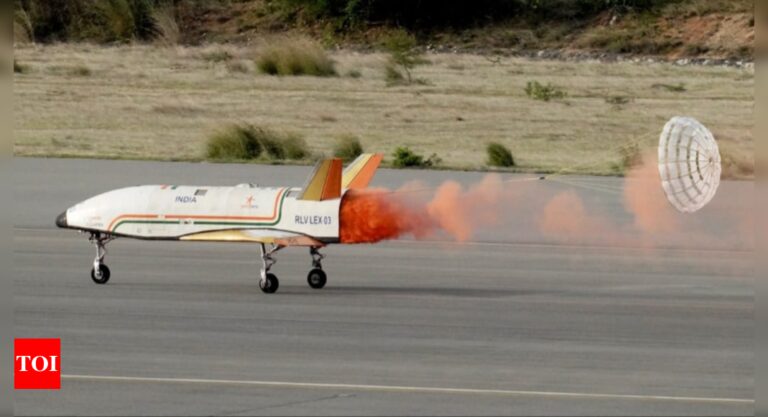
[ad_1]
BENGALURU: Isro, which had, on March 22 completed the second landing experiment of its reusable launch vehicle (RLV) — “RLV-LEX-02” — Sunday conducted the third landing experiment (RLV-LEX-03), paving the way for an orbital re-entry test.
The test was conducted at 7.10am at the Aeronautical Test Range (ATR) at Challakere in Chitradurga district, some 220km from Bengaluru.The RLV project is an important programme that will demonstrate one of the technologies needed to meet India’s ambitions of sustained human presence in space.
The RLV-LEX-03, built upon RLV-LEX-02, was aimed at improving the vehicle’s performance, guidance, and landing capabilities. TOI had reported last week that, weather permitting, Isro would attempt to achieve this milestone in the development of RLV technology this week.
S Unnikrishnan Nair, director, Vikram Sarabhai Space Centre (VSSC), which has developed the RLV, had told TOI that compared to the previous LEX, Nair said, RLV-LEX3 will be more challenging as the “intentional cross-range error of around 500m will be tested, compared to around 150m during LEX-02 and that the velocity azimuth with respect to the runway centre was adjusted to 2°, deviating from the previous mission’s 0° alignment.
On Sunday, Isro said: “RLV-LEX-03 re-demonstrated the autonomous landing capability of the RLV under more challenging release conditions (cross range of 500 m) and more severe wind conditions. The vehicle, named ‘Pushpak, was released from an IAF Chinook helicopter at an altitude of 4.5km.”
From a release point, the vehicle autonomously executed cross-range correction manoeuvres, approached the runway and performed a precise horizontal landing at the runway centreline. “Due to its low lift-to-drag ratio aerodynamic configuration, the landing velocity exceeded 320kmph, compared to 260kmph for a commercial aircraft and 280 kmph for a typical fighter aircraft.,” Isro said.
After touchdown, the vehicle velocity was reduced to nearly 100kmph using its brake parachute, after which the landing gear brakes were employed for deceleration and stop on the runway.
“During this ground roll phase, the vehicle utilised its rudder and nose wheel steering system to autonomously maintain a stable and precise ground roll along the runway, Isro said, adding that the mission simulated the approach and landing interface and high-speed landing conditions for a vehicle returning from space,” Isro said.
The mission had another advancement: Implementation of an advanced guidance algorithm that can simultaneously correct errors in both the longitudinal and lateral planes — essential for the future orbital re-entry mission. This decoupled algorithm, an improvement over LEX-02’s approach, will be utilised to enhance the reusable launch vehicle’s precision and control.
“The RLV-LEX uses multisensor fusion including sensors like inertial sensor, radar altimeter, flush air data system, pseudolite system and NaviC. Notably, the mission reused the winged body and flight systems as such without any modification, from the LEX-02 mission, demonstrating the robustness of Isro’s capability of design to reuse flight systems for multiple missions,” Isro said.
This mission simulates the approach & landing interface and high-speed landing conditions for a vehicle returning from space, which will reaffirm Isro’s expertise in acquiring the most critical technologies required for the development of an RLV.
The test was conducted at 7.10am at the Aeronautical Test Range (ATR) at Challakere in Chitradurga district, some 220km from Bengaluru.The RLV project is an important programme that will demonstrate one of the technologies needed to meet India’s ambitions of sustained human presence in space.
The RLV-LEX-03, built upon RLV-LEX-02, was aimed at improving the vehicle’s performance, guidance, and landing capabilities. TOI had reported last week that, weather permitting, Isro would attempt to achieve this milestone in the development of RLV technology this week.
S Unnikrishnan Nair, director, Vikram Sarabhai Space Centre (VSSC), which has developed the RLV, had told TOI that compared to the previous LEX, Nair said, RLV-LEX3 will be more challenging as the “intentional cross-range error of around 500m will be tested, compared to around 150m during LEX-02 and that the velocity azimuth with respect to the runway centre was adjusted to 2°, deviating from the previous mission’s 0° alignment.
On Sunday, Isro said: “RLV-LEX-03 re-demonstrated the autonomous landing capability of the RLV under more challenging release conditions (cross range of 500 m) and more severe wind conditions. The vehicle, named ‘Pushpak, was released from an IAF Chinook helicopter at an altitude of 4.5km.”
From a release point, the vehicle autonomously executed cross-range correction manoeuvres, approached the runway and performed a precise horizontal landing at the runway centreline. “Due to its low lift-to-drag ratio aerodynamic configuration, the landing velocity exceeded 320kmph, compared to 260kmph for a commercial aircraft and 280 kmph for a typical fighter aircraft.,” Isro said.
After touchdown, the vehicle velocity was reduced to nearly 100kmph using its brake parachute, after which the landing gear brakes were employed for deceleration and stop on the runway.
“During this ground roll phase, the vehicle utilised its rudder and nose wheel steering system to autonomously maintain a stable and precise ground roll along the runway, Isro said, adding that the mission simulated the approach and landing interface and high-speed landing conditions for a vehicle returning from space,” Isro said.
The mission had another advancement: Implementation of an advanced guidance algorithm that can simultaneously correct errors in both the longitudinal and lateral planes — essential for the future orbital re-entry mission. This decoupled algorithm, an improvement over LEX-02’s approach, will be utilised to enhance the reusable launch vehicle’s precision and control.
“The RLV-LEX uses multisensor fusion including sensors like inertial sensor, radar altimeter, flush air data system, pseudolite system and NaviC. Notably, the mission reused the winged body and flight systems as such without any modification, from the LEX-02 mission, demonstrating the robustness of Isro’s capability of design to reuse flight systems for multiple missions,” Isro said.
This mission simulates the approach & landing interface and high-speed landing conditions for a vehicle returning from space, which will reaffirm Isro’s expertise in acquiring the most critical technologies required for the development of an RLV.
[ad_2]
